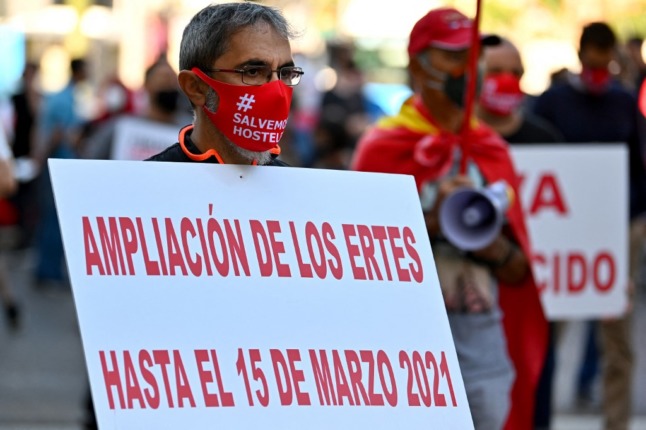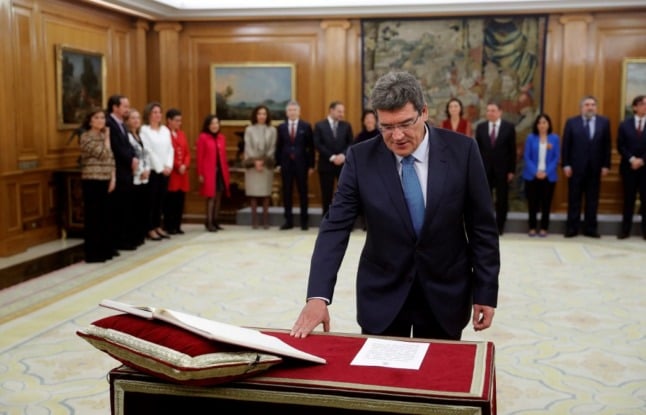What was the problem?
The Spanish government has been debating whether to extend the country’s furlough until September 2021, with the scheme – dubbed ERTE in Spanish – due to expire on May 31st 2021.
There’s been one major stumbling block: Spanish Social Security Minister José Luis Escrivá has wanted to change the conditions for exemptions from paying social security fees for those companies on furlough.
Escrivá aimed for these exonerations to be greater for ERTE companies that restart work activities again and lower for those who stick to the furlough scheme and keep their doors closed.
This approach of incentivising businesses to reopen is shared by Economy Affairs Minister Nadia Calviño.
The current ERTE scheme establishes a 100 percent exemption on the employee’s and employer’s part in terms of social contributions for companies with fewer than 50 workers (90 percent for companies with 50+ workers) that are prevented from working in any of their places of employment due to the coronavirus crisis. The contribution exemption percentage drops the longer ERTE workers are on the scheme.
The only point there’s been some consensus on is that this ERTE extension would last four months until September 30th 2021. The scheme has already been extended on four occasions since the beginning of the pandemic in 2020.
Spain’s Labour Ministry has also committed itself to keeping the ERTE scheme with 70 percent of the regulatory base, prevent employers from laying off workers in the first six months after they stop their ERTE, maintain the counter at zero for the period of benefits and include intermittent permanent workers (trabajadores fijos discontinuos) in the scheme.
What has been the reaction by the unions?
Spanish business associations and unions have rejected Escrivá’s proposal and argued that SMEs can’t handle the extra financial burden yet, with sources close to the negotiation telling El Mundo: “if it is not an extension of the current scheme, the Spanish government will have to go at it alone”.
Mari Cruz Vicente of Spain’s biggest union CCOO said :”We hope that this will be solved promptly so that it can go to the Council of Ministers and give security and certainty to both workers and companies. If not, someone will have to assume this irresponsibility and that is not us, of course”.
The president of the Spanish business association CEOE Antonio Garamendi warned the Spanish government that the negotiation “is not a marketing scheme” and that the current decree must be extended as it is.
“I think the unions have the same opinion: an extension is an extension, it is 20 more minutes with the same rules and with the same ball, not with other rules and another ball,” Garamendi put it metaphorically.

The scheme has already been extended on several occasions. Photo: Gabriel Bouys/AFP
Have they reached an agreement?
On Wednesday May 26th the Spanish government and representatives of Spain’s workers’ associations reached a last minute agreement for the fifth extension of the ERTE scheme, which will run from June 1st until September 30th 2021 and support 600,000 workers who are currently on temporary redundancy.
Sources close to the negotiations have said both sides started seeing eye to eye after Prime Minister Pedro Sánchez phoned CEOE leader Antonio Garamendi. What is clear is that Social Security Minister Escrivá conceded and agreed to keep the ERTE’s contributions conditions practically the same as they have been up to now, with the small exception that come the start of September companies that haven’t left the ERTE will need to pay slightly more in contributions.
Companies with fewer than 50 employees in “ultra-protected sectors” (tourism for example) will get to enjoy the same contributions exemptions as now in June, July and August, which is 85 percent. But this exoneration will drop to 70 percent in September, still better than the 45 percent suggested by Escrivá.
If companies reopen and welcome back employees they will benefit from a reduction in contributions identical to those still on ERTE (85 percent), 95 percent for the following four months, so they will only pay 5 percent in contributions.
The current ERTE scheme which establishes a 100 percent exemption from social contributions for companies with fewer than 50 workers will continue in place, but the figure will drop to 85 percent in June and July and to 75 percent in August and September.
The same applies to the already existing 90 percent exemption for companies with 50+ workers which will be 75 percent in the first two months and 65 in the following two.
The Spanish government has also agreed to extend the exemption from contributions to self-employed workers who haven’t been able to work as a result of the Covid crisis, even those who have already benefited from these conditions. This will reportedly assist 460,000 autónomos.
What is Spain’s ERTE scheme?
During the current coronavirus crisis, many companies have been forced to make employees temporarily redundant, most likely because their businesses couldn’t operate under the lockdown.
There is a mechanism in place called the ERTE (expediente de regulación temporal de empleo) which allows companies to issue temporary redundancy to its workforce as a result of the force majeure which in this case is the coronavirus crisis.
It is a regulation that effectively suspends the contract of a worker – or reduces their working hours – for as long as is deemed necessary during the crisis.
Under the ERTE, workers are still technically employed by the company which still pays their social security contributions but does not have to pay their salary.
Instead the ERTE enables those who are entitled to it, to claim unemployment benefit – which will be up to 70 percent of their original salary.
When the period covered by the ERTE is over, the worker then resumes their role under the same contract and is subject to the same conditions.
The employee will be told that the scheme is being enacted and the good news is that the worker doesn’t have to do anything about it. The company is legally obliged to apply to the Labour Authorities within 5 days. The Labour authorities will then authorise the process and assess whether unemployment benefit is due.



 Please whitelist us to continue reading.
Please whitelist us to continue reading.
Member comments